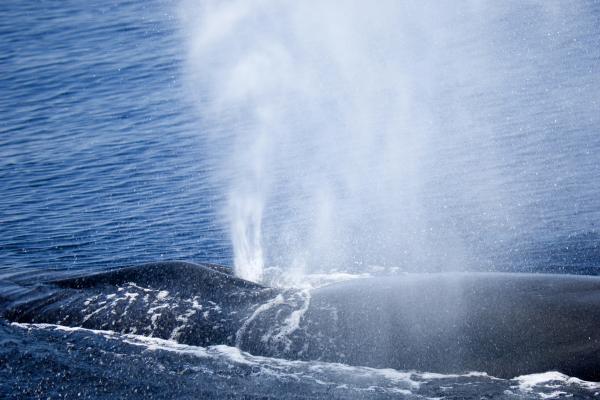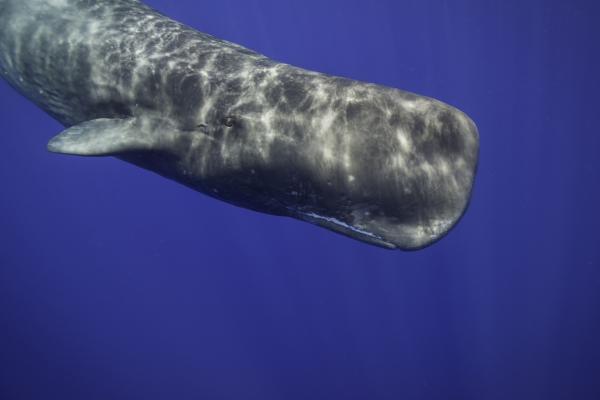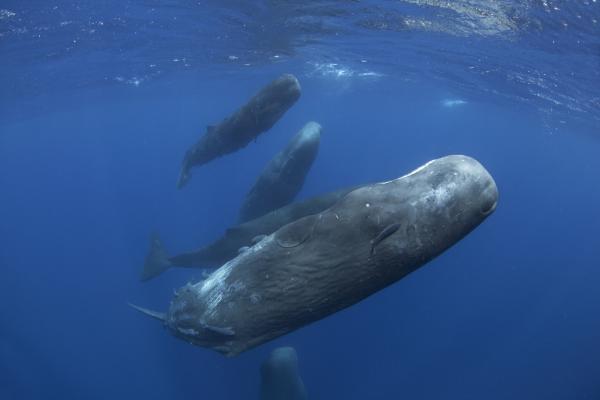The sperm whale (scientific name: Physeter catodon), also known as the giant-headed whale, stands as one of the largest toothed whales and the most iconic deep-sea predators on our planet. This remarkable marine mammal is famous for its enormous head, unique adaptations, and record-breaking diving abilities. In this article, you’ll discover in detail the features, habits, global distribution, feeding strategies, reproduction, and key differences between sperm whales and true baleen whales.

Sperm whales belong to the suborder Odontoceti (toothed whales). They possess a range of unique features that set them apart from other cetaceans:
Massive Squared Head: The sperm whale's head accounts for nearly one-third of its total body length. This head houses the spermaceti organ, filled with waxy oil, believed to aid in buoyancy regulation and enhance echolocation during deep dives.
Streamlined Body: Their bodies are hydrodynamic, with thick, wrinkled, mostly gray or brownish skin. Some rare individuals are albino.
Fin Adaptations: Forelimbs have evolved into flippers, hind limbs are absent, and the broad, flat tail fin provides powerful propulsion. The dorsal fin is small.
Thick Blubber: A thick layer of blubber beneath the skin insulates them against frigid deep-sea temperatures.
Unique Blowhole: The blowhole is located on the left side of the head, producing a distinctive angled spout.
Enormous Size: Adult males reach 16–20 meters in length (over 50 feet) and can weigh over 50 tons, making them the largest toothed animals alive.
There are three recognized sperm whale species:
Sperm whale (Physeter catodon): The largest and most widespread.
Pygmy sperm whale (Kogia breviceps): Much smaller, only 2.7–3.4 meters long.
Dwarf sperm whale (Kogia sima): Reaches about 3 meters in length.
This article will focus on the classic giant sperm whale (P. catodon).
Sperm whales are found in all of the world’s oceans, making them one of the most cosmopolitan marine mammals:
Deep-Ocean Specialists: They prefer deep offshore waters, especially along continental slopes, submarine canyons, and abyssal plains.
Occasional Coastal Presence: In some areas, sperm whales can be seen near deep coastal waters but rarely venture into shallow seas.
Highly Migratory: Sperm whales undertake long-distance migrations in search of food and suitable breeding grounds.
Extreme Depth Adaptations: They are known for their ability to thrive in ocean depths of over 3,000 meters (9,800 feet).

As apex predators of the deep sea, sperm whales possess extraordinary adaptations for hunting:
Primary Diet: Their main prey is giant squid (genus Architeuthis), but they also consume various fish, octopuses, and crustaceans.
Echolocation: Sperm whales use sophisticated echolocation clicks to hunt and navigate in the pitch-black ocean depths.
Deep Diving: They routinely dive to depths of 1,000 meters (3,280 feet) and can reach over 3,000 meters. Dives can last between 30 and 90 minutes.
Powerful Sonic Attacks: Recent research suggests sperm whales may use intense clicks to stun or disorient prey.
Huge Appetite: An adult sperm whale can consume up to one ton of food per day.
Sexual Maturity: Females mature at 8–10 years, males at around 10 years (but usually breed at 25+).
Reproductive Cycle: Sperm whales reproduce once every 4–6 years. Each birth yields a single calf, with a gestation period of 14–16 months and up to 2 years of nursing.
Longevity: Sperm whales can live for more than 70 years.
Social Structure: Females and young form stable matriarchal groups (“pods”), while adult males often live solitary lives or in bachelor groups.

Highly Social: Females and their calves form close-knit groups that provide mutual protection and aid in raising young.
Defensive Strategies: When threatened, pods will form protective circles around calves or sick members to fend off predators like orcas.
Vocal Communication: Sperm whales produce complex “clicks” for social bonding and group coordination.
Solitary Males: Mature males tend to roam alone except during breeding seasons.
Though often called “whales,” sperm whales differ significantly from true baleen whales:
| Feature | Sperm Whale (Odontoceti) | Baleen Whale (Mysticeti) |
|---|---|---|
| Teeth/Baleen | Conical teeth in lower jaw | Baleen plates, no teeth |
| Diet | Squid, fish (active hunter) | Plankton, krill (filter feeder) |
| Head Shape | Large, blocky head | Long, narrow head |
| Blowhole | Single, left-side blowhole | Double blowhole, center |
| Family | Physeteridae | Balaenidae, Balaenopteridae |
| Feeding Style | Echolocation, pursuit | Filter feeding |

Sperm whales have faced significant threats from commercial whaling, pollution, and entanglement. International whaling bans have helped populations stabilize, but illegal hunting and environmental challenges remain. Protecting sperm whales and their habitats is essential for healthy marine ecosystems.
For more fascinating facts about ocean wildlife and conservation, check out our Wild Animals Encyclopedia!
Bibliography
Beatty, R., Beer, A., & Deeming, C. (2010). The Book of Nature. Great Britain: Dorling Kindersley.
animal tags: cachalot
We created this article in conjunction with AI technology, then made sure it was fact-checked and edited by a Animals Top editor.